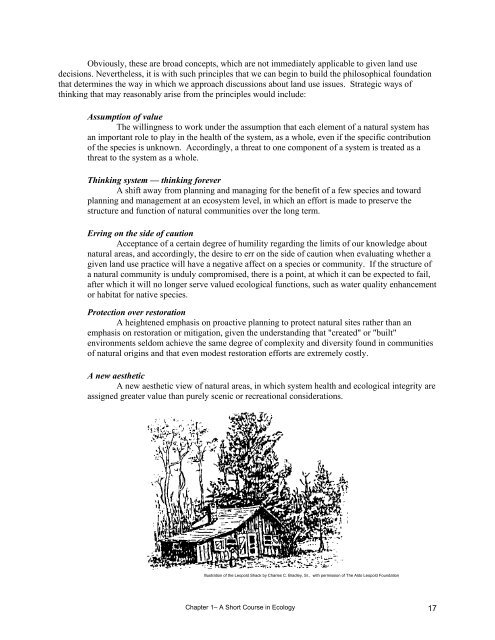Guide to Significant Wildlife Habitat - Door County Web Map
Guide to Significant Wildlife Habitat - Door County Web Map
Guide to Significant Wildlife Habitat - Door County Web Map
You also want an ePaper? Increase the reach of your titles
YUMPU automatically turns print PDFs into web optimized ePapers that Google loves.
Obviously, these are broad concepts, which are not immediately applicable <strong>to</strong> given land use<br />
decisions. Nevertheless, it is with such principles that we can begin <strong>to</strong> build the philosophical foundation<br />
that determines the way in which we approach discussions about land use issues. Strategic ways of<br />
thinking that may reasonably arise from the principles would include:<br />
Assumption of value<br />
The willingness <strong>to</strong> work under the assumption that each element of a natural system has<br />
an important role <strong>to</strong> play in the health of the system, as a whole, even if the specific contribution<br />
of the species is unknown. Accordingly, a threat <strong>to</strong> one component of a system is treated as a<br />
threat <strong>to</strong> the system as a whole.<br />
Thinking system — thinking forever<br />
A shift away from planning and managing for the benefit of a few species and <strong>to</strong>ward<br />
planning and management at an ecosystem level, in which an effort is made <strong>to</strong> preserve the<br />
structure and function of natural communities over the long term.<br />
Erring on the side of caution<br />
Acceptance of a certain degree of humility regarding the limits of our knowledge about<br />
natural areas, and accordingly, the desire <strong>to</strong> err on the side of caution when evaluating whether a<br />
given land use practice will have a negative affect on a species or community. If the structure of<br />
a natural community is unduly compromised, there is a point, at which it can be expected <strong>to</strong> fail,<br />
after which it will no longer serve valued ecological functions, such as water quality enhancement<br />
or habitat for native species.<br />
Protection over res<strong>to</strong>ration<br />
A heightened emphasis on proactive planning <strong>to</strong> protect natural sites rather than an<br />
emphasis on res<strong>to</strong>ration or mitigation, given the understanding that "created" or "built"<br />
environments seldom achieve the same degree of complexity and diversity found in communities<br />
of natural origins and that even modest res<strong>to</strong>ration efforts are extremely costly.<br />
A new aesthetic<br />
A new aesthetic view of natural areas, in which system health and ecological integrity are<br />
assigned greater value than purely scenic or recreational considerations.<br />
Illustration of the Leopold Shack by Charles C. Bradley, Sr., with permission of The Aldo Leopold Foundation<br />
Chapter 1– A Short Course in Ecology 17





![A Guide to the Control and Management of Invasive Phragmites [PDF]](https://img.yumpu.com/19126786/1/190x190/a-guide-to-the-control-and-management-of-invasive-phragmites-pdf.jpg?quality=85)






![Homeowner's Guide to Japanese Knotweed Control [PDF]](https://img.yumpu.com/19126766/1/190x245/homeowners-guide-to-japanese-knotweed-control-pdf.jpg?quality=85)




